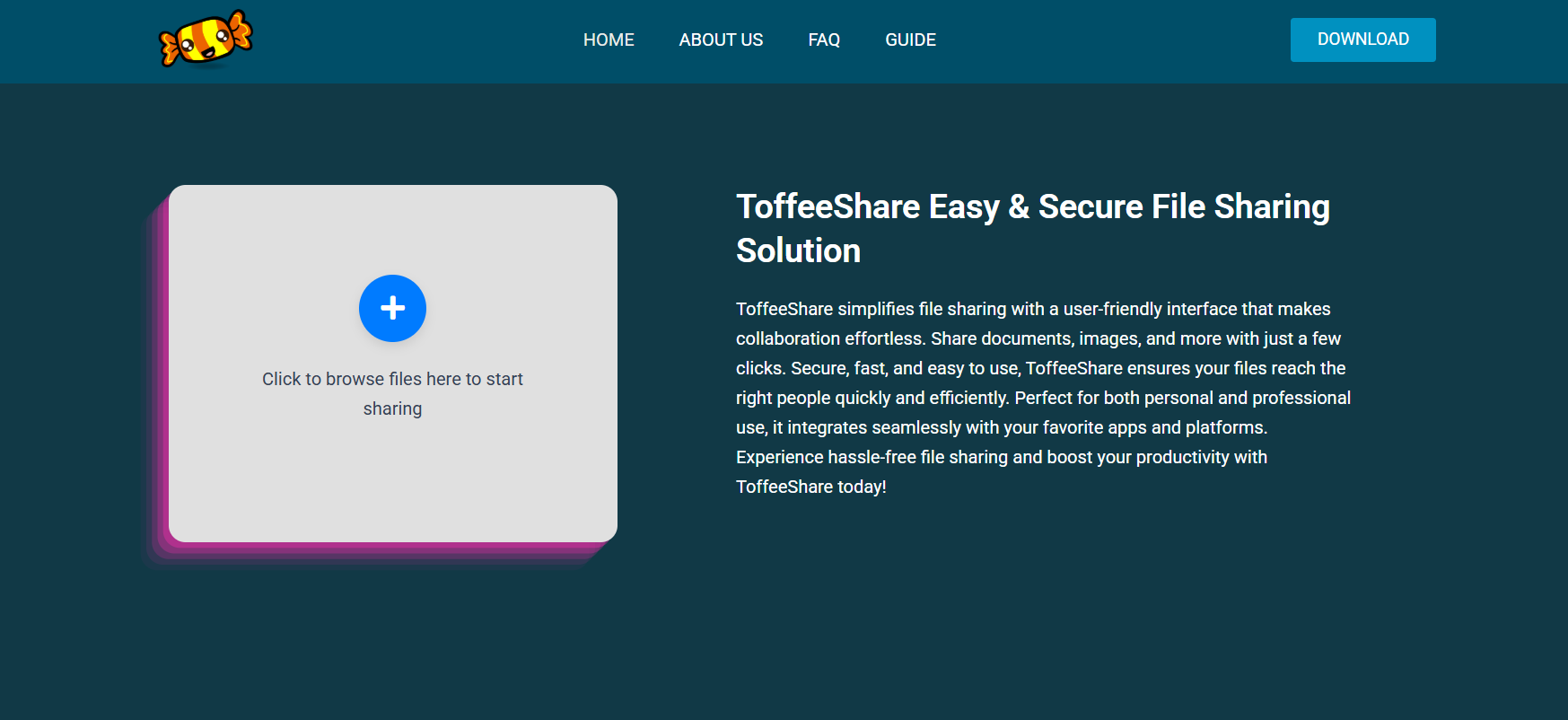The need for secure file sharing solutions has never been greater. ToffeeShare has gained popularity for offering fast, encrypted, peer-to-peer file transfers without requiring any registration or storing user data on servers. But how secure is ToffeeShare’s peer-to-peer system in reality?
This article breaks down the architecture, security measures, and real-world implications of ToffeeShare’s technology. If you’re thinking of using it for sensitive documents, large files, or confidential collaborations, understanding its security foundation is essential.
Built on Peer-to-Peer File Sharing
ToffeeShare operates on a peer-to-peer (P2P) system, which means files are transferred directly between the sender and the recipient. There are no intermediary servers that store the data, reducing exposure to third-party access or server breaches.
Unlike cloud services like Google Drive or Dropbox, which upload your files to centralized storage, ToffeeShare avoids permanent hosting altogether. When you share a file, it moves across a direct connection, staying within the control of both endpoints throughout the entire process.
This architecture has several inherent security and privacy advantages, including:
- No centralized storage that could be hacked or subpoenaed
- No file remains on ToffeeShare servers after the transfer ends
- Transfer only occurs when both devices are online and connected
End-to-End Encryption as a Core Mechanism
One of the strongest points in ToffeeShare’s security approach is its use of end-to-end encryption (E2EE). This means that the content is encrypted on the sender’s device and can only be decrypted by the recipient.
No intermediate node, not even ToffeeShare itself, can access the file contents. This minimizes the risk of data interception, even if a malicious party tries to monitor network traffic.
ToffeeShare leverages WebRTC (Web Real-Time Communication) to establish peer connections and DTLS/SRTP encryption protocols to safeguard data in transit. These technologies are industry-standard and commonly used in secure video conferencing apps and browser-based communications.
Once a transfer begins, WebRTC helps the two devices communicate directly, using NAT traversal to bypass firewalls if needed. Encryption keys are exchanged securely, and data is chunked into packets before sending.
No Login, No Metadata Logging
Unlike most file-sharing platforms, ToffeeShare does not require account creation or logins. This might seem like a convenience feature at first, but it’s also a privacy-centric decision.
No login means:
- No usernames or passwords to steal
- No personal identification tied to your files
- No email-based tracking or marketing traps
Moreover, ToffeeShare claims not to log metadata, such as IP addresses, filenames, or transfer timestamps. Without a user database or centralized analytics system, there’s very little information that can be harvested, sold, or leaked.
This no-metadata approach aligns well with modern digital privacy demands, especially for users looking to avoid surveillance or data monetization.
Session-Based Transfers Only
ToffeeShare operates using one-time session-based file transfers, which means that the file exists in a transferable state only while both users are connected.
As soon as the sender closes the browser window or the receiver finishes downloading the file, the session ends. There’s no residual data, no history, and no recovery options.
This is a double-edged sword. On the one hand, it’s excellent for security—there’s nothing to steal later. On the other hand, it means you need to ensure that the recipient is ready and available to receive the file immediately. There are no links to “download later.”
From a security point of view, this ephemeral nature makes attacks significantly harder because attackers don’t have windows of opportunity to exploit dormant links or stored files.
Vulnerability to Man-in-the-Middle Attacks?
Despite its many strengths, no system is completely immune to threats. One potential concern with peer-to-peer systems, even when using encryption, is the risk of man-in-the-middle (MITM) attacks during connection negotiation.
ToffeeShare utilizes browser-based WebRTC, and although it leverages HTTPS and secure transport protocols, the connection relies on a link or QR code sent between the parties. If that link is intercepted or spoofed, there is a theoretical possibility that a third party could pose as the recipient or sender.
ToffeeShare mitigates this risk using randomized links and short-lived sessions, but link-sharing methods still matter. For maximum safety, sharing the ToffeeShare link over a secure channel—such as an encrypted messaging app—is highly recommended.
No Permanent File Ownership or Controls
Security-conscious users often look for digital rights management (DRM) or access control features like revoking access, setting file expiration dates, or limiting the number of downloads.
ToffeeShare, by design, does not offer such features. Since the system doesn’t host files or manage accounts, there’s no persistent control layer. Once the file is transferred, the sender has no further control over it.
This can be both good and bad:
- Good: No data is held on servers, reducing long-term exposure
- Bad: No ability to manage access after sharing
If you’re sending highly sensitive documents and want lasting control, ToffeeShare may need to be paired with encrypted containers (like password-protected ZIP files or PGP-encrypted files).
Minimal Attack Surface for Hackers
Cloud-based platforms attract hackers because of the centralized attack surface—breach a server, and you get access to thousands or millions of user files.
ToffeeShare, by contrast, offers an almost zero-value target from a hacker’s perspective. Since:
- Files aren’t stored
- Users aren’t tracked
- No databases or login systems exist
…there’s nothing to attack or exfiltrate. The absence of storage and account infrastructure shrinks the potential breach zone considerably.
This kind of system design is aligned with “zero trust” security principles, where minimizing trust assumptions at every layer leads to lower systemic risks.
Open Technology Stack with Transparent Practices
ToffeeShare is built on widely used, open web technologies like WebRTC and HTTPS. These technologies are audited, tested, and adopted by major industry players, increasing confidence in their reliability.
While ToffeeShare is not fully open-source, its reliance on transparent, standards-based protocols offers a degree of public scrutiny. The developers also maintain a clear privacy policy that emphasizes no tracking, no ads, and no third-party sharing.
Transparency and simplicity contribute to trust. Unlike proprietary systems with opaque encryption schemes, ToffeeShare’s reliance on proven tech makes it easier for security experts to assess and validate its claims.
File Size Limits and Performance Considerations
Security often comes with trade-offs, but ToffeeShare manages to offer impressive performance without compromising privacy.
There is no file size limit imposed by ToffeeShare itself. However, practical limitations depend on your browser and device memory. Since the file must be held in memory during transfer, especially for large files, users might experience:
- Browser lag or crashing during huge transfers
- Timeouts due to network fluctuations
- Device heating or resource constraints
From a security perspective, these are not flaws—just operational considerations. The real risk would arise only if users switch to insecure alternatives after facing performance hiccups.
Best Practices for Secure Usage
Even with strong built-in protections, user behavior determines the ultimate security of any tool. To make the most of ToffeeShare’s system:
- Always verify the recipient’s identity before sharing a link
- Use encrypted communication channels for sharing the file link
- Don’t use public or shared computers for sensitive transfers
- Close the session tab after the transfer completes
- Use additional encryption (ZIP passwords or PGP) for high-value files
These extra layers ensure that even if the sharing link gets compromised, the content remains protected.
Comparison with Other File Sharing Tools
Compared to cloud services like WeTransfer, Dropbox, or Google Drive, ToffeeShare excels in ephemeral sharing and privacy. However, it does lack the collaborative and convenience features that cloud users enjoy.
| Feature | ToffeeShare | Google Drive | WeTransfer |
| End-to-End Encryption | Yes | No (server-side) | No (server-side) |
| Account Needed | No | Yes | Optional |
| File Hosting | None | Yes | Temporary |
| Size Limit | Browser dependent | 15GB+ (paid) | 2GB (free) |
| Link Persistence | Session-only | Long-term | 7-day default |
ToffeeShare clearly caters to users who value instant privacy and no tracking, rather than those looking for persistent collaboration or long-term file access.
Final Thoughts
ToffeeShare’s peer-to-peer system is a strong example of minimalist security done right. By eliminating storage, accounts, and data logs, it reduces both complexity and risk. Its reliance on open, encrypted, browser-based protocols allows it to deliver high-speed transfers while maintaining user privacy.
For those who need a quick, anonymous, and secure way to send files without leaving a digital trail, ToffeeShare is among the safest available tools. It’s not a replacement for cloud storage or team collaboration tools, but it fills a unique niche—secure, private, one-time file transfers with minimal overhead.







